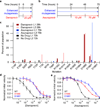A system for the continuous directed evolution of proteases rapidly reveals drug-resistance mutations
- PMID: 25355134
- PMCID: PMC4215169
- DOI: 10.1038/ncomms6352
A system for the continuous directed evolution of proteases rapidly reveals drug-resistance mutations
Abstract
The laboratory evolution of protease enzymes has the potential to generate proteases with therapeutically relevant specificities and to assess the vulnerability of protease inhibitor drug candidates to the evolution of drug resistance. Here we describe a system for the continuous directed evolution of proteases using phage-assisted continuous evolution (PACE) that links the proteolysis of a target peptide to phage propagation through a protease-activated RNA polymerase (PA-RNAP). We use protease PACE in the presence of danoprevir or asunaprevir, two hepatitis C virus (HCV) protease inhibitor drug candidates in clinical trials, to continuously evolve HCV protease variants that exhibit up to 30-fold drug resistance in only 1 to 3 days of PACE. The predominant mutations evolved during PACE are mutations observed to arise in human patients treated with danoprevir or asunaprevir, demonstrating that protease PACE can rapidly identify the vulnerabilities of drug candidates to the evolution of clinically relevant drug resistance.
Figures




References
-
- Schilling O, Overall CM. Proteome-derived, database-searchable peptide libraries for identifying protease cleavage sites. Nat Biotechnol. 2008;26:685–694. - PubMed
-
- Walsh G. Biopharmaceutical benchmarks 2006. Nat Biotechnol. 2006;24:769–776. - PubMed
-
- Wehr MC, et al. Monitoring regulated protein-protein interactions using split TEV. Nat Methods. 2006;3:985–993. - PubMed
Publication types
MeSH terms
Substances
Grants and funding
LinkOut - more resources
Full Text Sources
Other Literature Sources

